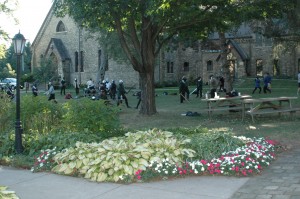Any day you get to train in the Art of the medieval Italian sword master, Fiore dei Liberi, is a good day. When you find yourself at The 600 – a 3-day, “All Fiore, All the Time” workshop hosted by the Chicago Swordplay Guild, you’ve pretty much died and gone to heaven.
At least, that’s the opinion shared by the close to 50 western martial artists from the US, Canada and Europe who converged on the DeKoven Center in Wisconsin last month to honor Fiore, his Art and the 600th anniversary of the presentation of his Il Fior di Battaglia (the Flower of Battle) to his patron, Niccolò III d’Este, Marchese of Ferrara (1383-1441).
Held from Friday, September 10th through Sunday, September 12th on the beautiful, picturesque grounds that are also home to the biannual Western Martial Arts Workshop (WMAW), The 600 gave students of Fiore’s Art a deep, personal immersion experience, with intensive training offered by well-respected instructors from the Historical European Swordplay community: our own Gregory Mele, Chicago Swordplay Guild (USA); Sean Hayes, Northwest Fencing Academy (USA); Guy Windsor, School of European Swordsmanship (Finland); Mark Lancaster, The Exiles, Company of Medieval Martial Artists (UK); Scott Wilson, Darkwood Armory (USA); and Bob Charrette, Forteza Historical Swordwork Guild (USA).
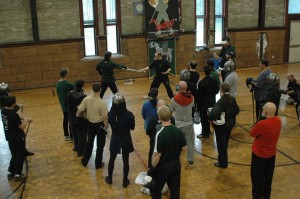 In addition to the formal classes offered, The 600 also included a fascinating panel discussion and Q&A on Fiore and his work, taking full advantage of the amazing brain trust of instructors we had on hand. It was the first time the CSG has included this kind of activity, and it was a big hit with the participants. The weekend also included two feats of arms – an unarmoured tournament of sword, dagger and lance open to everyone; and an Armoured Pas d’Armes, an invitational tournament that celebrated the knightly art with sword, lance, and axe.
In addition to the formal classes offered, The 600 also included a fascinating panel discussion and Q&A on Fiore and his work, taking full advantage of the amazing brain trust of instructors we had on hand. It was the first time the CSG has included this kind of activity, and it was a big hit with the participants. The weekend also included two feats of arms – an unarmoured tournament of sword, dagger and lance open to everyone; and an Armoured Pas d’Armes, an invitational tournament that celebrated the knightly art with sword, lance, and axe.
Several of the instructors remarked that the participants’ skill level and familiarity with armizare enhanced the teacher’s ability to challenge us more, mentally and physically than was typical in more “generalist” events. This made the learning experience all the more valuable to us. It also contributed to the glazed look of happy exhaustion shared by every student! Here are some of the class highlights:
Application of Fiore’s Art to Positions of Disadvantage (Scott Wilson) – We all love Scott Wilson for his incredibly beautiful swords (Darkwood Armory), and many of us enjoyed shopping from the back of his truck in between classes on Saturday. But, Scott is also a longtime martial artist and an excellent instructor. In this class, Scott gave us some very interesting ideas about using Boar’s Tooth as elbow shields against strikes and as offensive tools for CQC. Perhaps the most interesting lesson that Scott shared was his interpretation of Fiore’s daga vs. spada. Against a mandritto, Scott had us move directly into the strike, using the dagger to block the blow with as close to zero pressure as possible. After the block, Scott 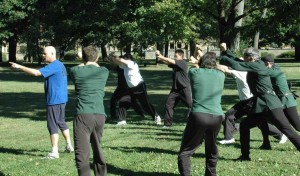 redirected the sword down and to his right, and from there used his dagger for a counter attack.
redirected the sword down and to his right, and from there used his dagger for a counter attack.
Improve Your Survival Odds with Proper Cutting Mechanics (Sean Hayes & Gregory Mele) – Sean is always one of our favorite guest instructors, bringing a depth of knowledge and contagious enthusiasm to all of his classes. While this was not a class on cutting basics, he worked us on the basics with gusto, helping us to hone our cutting skills using a coiled back-weighted stance for power and “hand protection”; correct hand-foot timing; how to cut fendente by pushing with the top hand and pulling with the bottom hand; targeting our cuts to strike “below the beard” (using our own Jacques and his beard “Francois” as a visual aid); 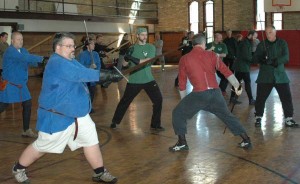 and projecting power with more effectiveness. We also learned from Greg how good solo drills are not just about moving from one guard to another – they are dynamic tools for examining how to attack and defend as if you are facing an opponent. After practicing a few sequences where we learned both agent’s and patient’s actions, we partnered up to train and examine why the patterns of attack/defend work as they do in a montante sequence called “Driving the Foe Before You”.
and projecting power with more effectiveness. We also learned from Greg how good solo drills are not just about moving from one guard to another – they are dynamic tools for examining how to attack and defend as if you are facing an opponent. After practicing a few sequences where we learned both agent’s and patient’s actions, we partnered up to train and examine why the patterns of attack/defend work as they do in a montante sequence called “Driving the Foe Before You”.
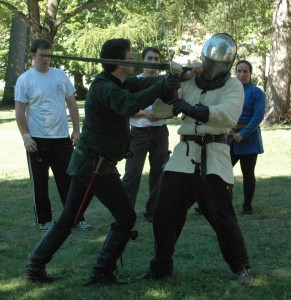 Down You Go: Two Ubiquitous Throws of Armizare (Greg Mele, assisted by Jesse Kulla CSG) – In this class, about a dozen students threw themselves into two of the most basic throws in the system – the “rear leg takedown” (hip throw) and the “collar throw” (diving throw) – learning important applications when unarmed and when using various weapons. When dealing with daggers, for example, Greg told us not to do just block with our hands, but to “swat his hand away like a bear.” Think of your defensive action as a powerful attack of its own. With swords, a pommel strike should be thought of as an “upper cut”. Instead of just striking your opponent, really knock his head back and up and follow through with a “diving throw”.
Down You Go: Two Ubiquitous Throws of Armizare (Greg Mele, assisted by Jesse Kulla CSG) – In this class, about a dozen students threw themselves into two of the most basic throws in the system – the “rear leg takedown” (hip throw) and the “collar throw” (diving throw) – learning important applications when unarmed and when using various weapons. When dealing with daggers, for example, Greg told us not to do just block with our hands, but to “swat his hand away like a bear.” Think of your defensive action as a powerful attack of its own. With swords, a pommel strike should be thought of as an “upper cut”. Instead of just striking your opponent, really knock his head back and up and follow through with a “diving throw”.
Playing with the Plays: Making Techniques Adaptable, Applicable and Fun (Guy Windsor) – Incorporating his concept that what we need to know tactically is always shown somewhere in the Maestro’s manuscripts (largely the Getty), Guy gave us some great training tools that center on linking Fiore’s plays. By examining the circumstances you are in, you can know what to do next (his “Decision Tree”). Guy also loves to draw on plays from all over the Getty, demonstrating how he sees the book as always interrelating, no matter what section you are reading. One of his favorite plays, for example, is the 8th Play of the Master of Coda Lunga on Horseback- the hand grab and pommel strike – found on the 6th to the last page of the manuscript and which Fiore says “counters all the plays that come before this” (Tom Leoni translation). 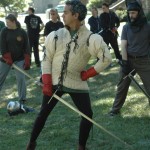
KISS – Keep it Simple Student (Mark Lancaster) – Our good friend from across the Pond taught his heart out and kept the laughter flowing, in spite of the fact he was still recovering from a slipped disk. In this class, Mark showed us how the four unarmed poste follow through into Fiore’s daga section and then into plays of the longsword as just a variation on a basic theme. One key lesson: students of armizare need to have the core of Fiore’s art internalized so that we don’t have to think about how to frame the poste and which guards have what characteristics. Mark also shared his insights on the position of the first Master of the Dagger. As Greg has pointed out to us 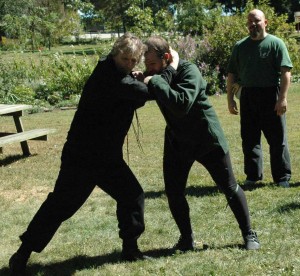 numerous times, this position is seen several times throughout Il Fior di Battaglia, especially in the sword in one hand section.
numerous times, this position is seen several times throughout Il Fior di Battaglia, especially in the sword in one hand section.
Zogho Stretto – Breaking the Distance (Mark Lancaster) – Mark, also lovingly referred to “Puss in Boots”, took us into tactical options we have with the incrossada. When both players pass and cut fendente, binding on the forte of the blade and getting all sloppy in the Zogho Stretto, we have what he calls a “Train Wreck”. (Not a Fiore term, but the Maestro would have agreed had medieval Italy had a Metro system.) Avoiding this situation was the crux of his class, and Mark threw a lot of tactical options at us that we could employ. A couple key points: The attacker is always closing to Zogho Stretto if he is using single-tempo action. The defender can choose to engage at Stretto, or he can step out of range, moving offline or even taking a small step back to engage at Largo. The first decision lies with the defender. Mark also talked about the option of stepping without really going anywhere. Here you step forward and then back into place to change your lead foot, but distance stays the same. This was a challenging class for a lot of us, but we walked away with plenty of food for thought and fuel for future training.
How to Open a Can Without Cutting Yourself: Techniques for Fighting in Harness (Sean Hayes, assisted by Gregory Mele and Alex Spreier (Northwest Fencing Academy) – About 10 hearty students put on their kits – from full harness to virtually no harness – and joined Sean as he taught us how instructions for armoured fighting techniques are not only covered in Fiore’s spada en arme (sword used while in harness) sections of his manuscripts, but also in the abrazare, dagger, single-sword and two-handed sword sections.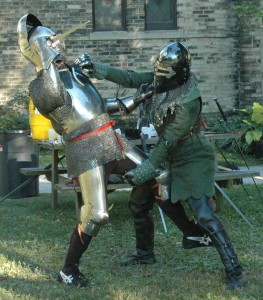
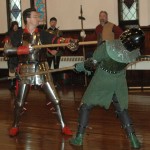 Ponderous, Cruel and Mortal: Dei Liberi’s System of Axe Play (Greg Mele) – This introductory class to Dei Liberi’s instructions on the poleaxe drew many new students of this weapon, including CSG’s very own master of the rapier, John O’Meara. Greg began with the poleaxe poste and then took us through set plays that drew on core actions of sword and spear play. As one energetic CSG novice noted, the poleaxe as a weapon is dramatic and well balanced, and its movement, “equal parts graceful and threatening”. No wonder it’s a favorite among so many of us.
Ponderous, Cruel and Mortal: Dei Liberi’s System of Axe Play (Greg Mele) – This introductory class to Dei Liberi’s instructions on the poleaxe drew many new students of this weapon, including CSG’s very own master of the rapier, John O’Meara. Greg began with the poleaxe poste and then took us through set plays that drew on core actions of sword and spear play. As one energetic CSG novice noted, the poleaxe as a weapon is dramatic and well balanced, and its movement, “equal parts graceful and threatening”. No wonder it’s a favorite among so many of us.
Attacker’s Choice: Responding to the Bind and Connecting Largo to Stretto (Guy Windsor) – For many of us, the most influential classes of the weekend were those taught by Guy. As one CSG free scholar noted: Guy’s interpretation of stretto and largo while crossed at the half-sword is a game-changer. His key point is that Zogho Largo and Zogho Stretto are more than a statement of measure. Zogho Largo is defined as a crossing of the swords 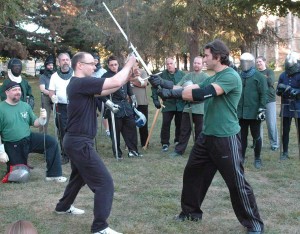 during which your opponent’s point is not threatening you, and the bind is soft enough that you can leave it without immediate fear of being struck. Zogho Stretto he describes as a crossing of the swords in which the opponent’s point threatens you, and he is bound hard enough that to remove pressure from the bind would lead to your immediate and painful death. Guy took us deeper into the plates and writings found in Fiore’s Flower of Battle, giving us a brilliant method for visualizing and teaching the concepts of range as it pertains to Fiore’s system.
during which your opponent’s point is not threatening you, and the bind is soft enough that you can leave it without immediate fear of being struck. Zogho Stretto he describes as a crossing of the swords in which the opponent’s point threatens you, and he is bound hard enough that to remove pressure from the bind would lead to your immediate and painful death. Guy took us deeper into the plates and writings found in Fiore’s Flower of Battle, giving us a brilliant method for visualizing and teaching the concepts of range as it pertains to Fiore’s system.
Patterns of Remedy: Treatise Organization and Internal Connections in Fior di Battaglia (Bob Charrette) – Hat’s off to Bob, because his fascinating presentation really fed the minds of the armizare scholars at The 600! Bob has reexamined Fiore’s system of Remedies, Scholars, Counters and Counter-Counters, setting it into visual synoptic tables that reveal an even higher level of internal organization and forethought than is generally recognized.
Spontaneous Tactical Response Skills for Freeplay (Sean Hayes) – Sean is a master at developing live drills that directly lead a student into free play. His class systematically developed each drill, first keeping things simple and even “choreographed”, and eventually added more and more variables until we were pretty much doing focused sparring. We also learned some great drills for training with odd numbers. The 3-person drill we did, where as soon as you defend, you turn and attack the third training partner, really turned up the intensity while allowing us to keeping training safely. At the end of the class, we were thoroughly warmed up enough for a few rounds of focused and spirited freeplay. Sean had us do two-minute rounds, with one person from each training trio marshaling and giving advice. 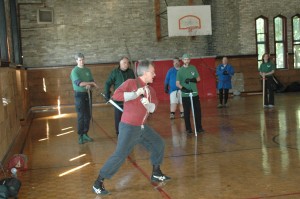
Round Table Discussion – All Instructors
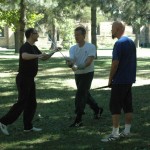 Rainy skies on Friday had us quickly change the afternoon schedule from medieval mud wrestling (so to speak) to a panel discussion that we students found both invaluable and amusing – thanks to the verbal cutting and cross-sniping between the instructors. The discussion kicked off with Mark’s question as to whether Fiore’s teachings were meant for battlefield combat or judicial tournaments. The consensus was “both”. As Greg put it, the “Art of Arms” is designed to teach you how to fight, with the question of what circumstances coming later. If you train for battlefield combat, you can apply those lessons to one-on-one circumstances and tournaments. However, if you just train for tournaments, it is difficult and perhaps deadly to apply those lessons on the battlefield. Other topics discussed involved what Fiore meant by a “zuparello” (a cloth “armor” jacket for fighting vs. a doublet); the importance of studying all of the Fiore manuscripts, not just one, and in turn studying all sections of the manuscripts; what is canonical in the manuscripts and what is not (if Fiore shows it or describes it, it is canonical); and how we need to expand our study beyond weapons and combat methods to the culture and physical artifacts of the time.
Rainy skies on Friday had us quickly change the afternoon schedule from medieval mud wrestling (so to speak) to a panel discussion that we students found both invaluable and amusing – thanks to the verbal cutting and cross-sniping between the instructors. The discussion kicked off with Mark’s question as to whether Fiore’s teachings were meant for battlefield combat or judicial tournaments. The consensus was “both”. As Greg put it, the “Art of Arms” is designed to teach you how to fight, with the question of what circumstances coming later. If you train for battlefield combat, you can apply those lessons to one-on-one circumstances and tournaments. However, if you just train for tournaments, it is difficult and perhaps deadly to apply those lessons on the battlefield. Other topics discussed involved what Fiore meant by a “zuparello” (a cloth “armor” jacket for fighting vs. a doublet); the importance of studying all of the Fiore manuscripts, not just one, and in turn studying all sections of the manuscripts; what is canonical in the manuscripts and what is not (if Fiore shows it or describes it, it is canonical); and how we need to expand our study beyond weapons and combat methods to the culture and physical artifacts of the time.
Of course, most of us came to test out our fencing skills, and we had plenty of opportunity!
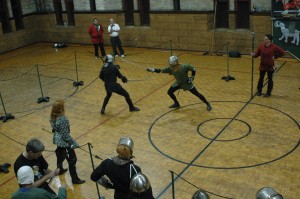 Unarmoured Tournament. The first fencing forum was an unarmoured tournament using the sword in two hands, sword in one hand, and spear. And was this FUN! The format was a variation on the Belgium rules, where each bout was fought till one player had accumulated three points. And the rules are tough – a strike to the head or the sword arm counted for three points. The winner of each bout remained “king of the ring”, and was allowed a king’s strike after being hit. It paid to be king: double-kills went to the higher strike on the body, with the king taking any ties. With the exception of the arming sword portion of the tournament, fencing was clean and crisp. Unfortunately, a lot of us started to default to our various Bolognese, backsword, SCA, and FMA experience – which we vow to you, Greg, will not happen at the next Fiore Con! Of course, following the tournament came the beer, scotch, cigars and hilarious storytelling.
Unarmoured Tournament. The first fencing forum was an unarmoured tournament using the sword in two hands, sword in one hand, and spear. And was this FUN! The format was a variation on the Belgium rules, where each bout was fought till one player had accumulated three points. And the rules are tough – a strike to the head or the sword arm counted for three points. The winner of each bout remained “king of the ring”, and was allowed a king’s strike after being hit. It paid to be king: double-kills went to the higher strike on the body, with the king taking any ties. With the exception of the arming sword portion of the tournament, fencing was clean and crisp. Unfortunately, a lot of us started to default to our various Bolognese, backsword, SCA, and FMA experience – which we vow to you, Greg, will not happen at the next Fiore Con! Of course, following the tournament came the beer, scotch, cigars and hilarious storytelling. 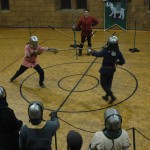
This year’s victors were Keith Jennings, CSG (Longsword), Scott Wilson, SAS (Arming sword – he edged Keith out by one fight), and Dave “Sparky” Farrell, CSG (spear). Had all bouts been combined, Keith would have been the victor. We are proud of you guys! And an extra salute goes to Mark Lancaster for his Fiore-inspired sword throw at Jesse during the martial challenge. Awesome, scary, and really cool!
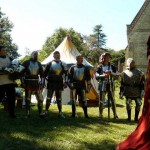 Armoured Tournament. The armoured deed of arms was an expansion of last year’s event at WMAW 2009. With the sun shining and crowds cheering from the sidelines, CSG’s Jesse Kulla, Dave “Sparky” Farrell and Leo Lastre stood as defenders and took challenges with sword, dagger, spear and axe from Bob Charrette, Sean Hayes, Alex Spreier and Scott Wilson. Scott’s spear bout with Leo is regarded by many as the highlight of the feat of arms. A “huzzah” with a wink must also be given to Bob Charrette for his cunning use of the powder-filled hollow poleaxe on Jesse. All in all, this whole event was just absolutely great to watch! See videos of the tournament on YouTube!
Armoured Tournament. The armoured deed of arms was an expansion of last year’s event at WMAW 2009. With the sun shining and crowds cheering from the sidelines, CSG’s Jesse Kulla, Dave “Sparky” Farrell and Leo Lastre stood as defenders and took challenges with sword, dagger, spear and axe from Bob Charrette, Sean Hayes, Alex Spreier and Scott Wilson. Scott’s spear bout with Leo is regarded by many as the highlight of the feat of arms. A “huzzah” with a wink must also be given to Bob Charrette for his cunning use of the powder-filled hollow poleaxe on Jesse. All in all, this whole event was just absolutely great to watch! See videos of the tournament on YouTube! 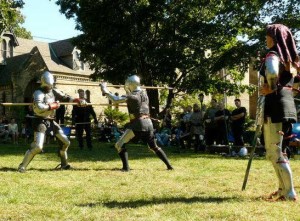
Our gratitude goes out to everyone who made The 600 possible! More images of the event are available for viewing.
WMAW 2011. CSG’s next major workshop is WMAW 2011, which will take place at the DeKoven Center in WI sometime in early Fall. Check WMAW.us for regular updates!
The 601? Will there be anything like The 600 Revisited? Stay tuned. The rave reviews we’ve received on The 600 have us thinking about another all-Fiore workshop in 2012…

